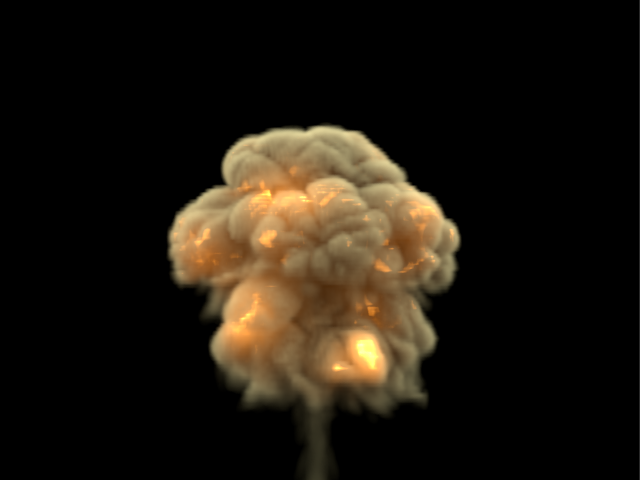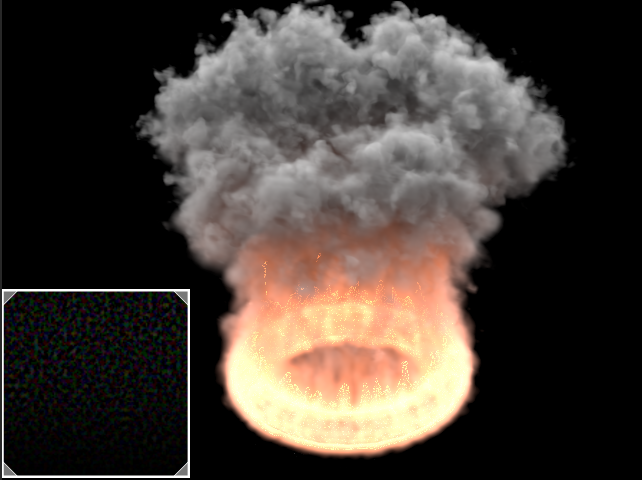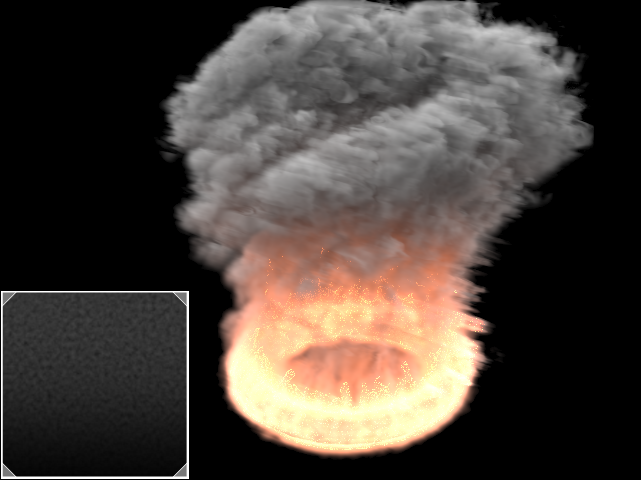This page provides information on the Volumetric Grid's Rendering tab.
Overview
The rendering properties part of the Volumetric Grid Parameters and is located on the Rendering tab when VRayVolumeGrid is selected. The options in this rollout specify how the VRayVolumeGrid effect will be rendered.
UI Path: ||Select VRayVolumeGrid|| > Properties Panel > VRayVolumeGrid node > Rendering tab
Rendering
Render presets... – Specifies a preset from a list of available render presets which might better suit caches from various source software tools.
Render mode – Specifies the technique used to visualize the grid content, which can also be considered the render mode for the effect. The first three options are volumetric in nature, while the last three are mesh-based.
Volumetric – Standard volumetric mode similar to VRayEnvironmentFog. This method is used mostly for fire and smoke. As with most volumetric shaders, it is based on the ray marching technique.
Volumetric Geometry – Used mostly to export deep images and render elements such as normals, velocity, etc. It produces the same result as Volumetric mode by using procedural geometry that contains multiple transparent layers.
Volumetric Heat Haze – Produces the same result as Volumetric Geometry mode, but enables a heat haze effect to simulate the visual distortion that occurs over hot surfaces (such as pavement in a hot environment). The Heat haze parameter determines the amount of haze. The traced ray changes its direction according to the Surface and Isosurface parameters. For more information, see the Heat Haze example below.
Isosurface – Used mostly for liquids. It produces a V-Ray procedural isosurface geometry using the options in the Surface and Isosurface parameters.
Mesh – The content is converted into a standard mesh using the Surface options. This mode is mostly used for liquids.
Enable rendering – When enabled, the cache will be rendered.
Rend. step (%) – Specifies the ray marching step as a percentage of the cell size. As the renderer traces rays through the VRayVolumeGrid, this tells it how often to get information from the grid. If the step is more than 100, some cells will be skipped and artifacts might be produced. When rendering atmospherics with a specific transparency curve, a lower percentage might be needed to preserve fine details. On the other hand, increasing the step increases the rendering speed. This parameter is used with the Volumetric Heat Haze and Isosurface modes. For more information, see the Rend. step (%) example below.
Shadow step (%) – Specifies the ray marching step for shadow rays as a percentage of the cell size. Usually it can be higher than the Rend. step (%), as shadows generally will not need as much detail, and increasing the shadow step will speed up rendering. Increasing the shadow step will improve rendering performance with dome and area lights in particular.
Fade out – Makes the content near the grid's boundaries more transparent in the event that sharp edges are not desired. This parameter controls how far from the boundaries the process should start.
Motion blur multiplier – Specifies a multiplier for the motion blur effect. Can be a negative number.
Sampler type – Determines how to calculate the values in the points with non-integer coordinates.
Box – Cells are displayed as cubes. There is no blending between neighbor cells. The fastest mode.
Linear – Blends between neighbor cells linearly to smooth out the effect's appearance. Sometimes this option might result in a visible grid-like effect. This type is roughly 20-30% faster than the Spherical type.
Spherical – Uses special weight-based sampling for the smoothest-looking fluid. With increasing resolution, the visual advantage over the Linear method becomes less noticeable.
Surface channel – Specifies the channel that defines the surface of the fluid. It is used for solid rendering and displacement.
Texture - the values of a custom texture will define the liquid surface.
Liquid/Temperature - the Liquid/Temperature channel will define the liquid surface. Temperature is typically in the range 0-1 for Liquid simulations and 600-2000 for Fire / Smoke simulations.
Smoke - the Smoke channel will define the liquid surface. Smoke is typically in the range of 0-1 for Fire / Smoke simulations.
Speed - the Speed channel will define the liquid surface. Speed channel output has to be enabled for this to work. Speed is calculated as the length of the velocity vector for each voxel.
Fuel - the Fuel channel will define the liquid surface. Fuel channel output has to be enabled for this to work.
Isosurface level – Allows you to specify a treshold value for the generation of the liquid surface. Grid cells below this value will be ignored. By default, the Isosurface Level is set to 0.5 and should only be modified if there is flickering in the generated geometry. Isosurface Level is used only in Isosurface and Mesh modes.
Invert volume – By default, the values above the surface level are considered internal. When enabled, this option swaps the inside and outside. Note that this should be enabled for OpenVDB level sets.
Mesh smoothing level – Specifies the number of smoothing passes. Higher values will produce smoother results but require more time to calculate.
Heat haze – When Render mode is set to Volumetric Heat Haze, this value acts as a multiplier for the amount of haze. A value of 1 corresponds approximately to the normal heat haze in air caused by the temperature. If smoke or other channel is selected as source, a larger multiplier may be required to achieve a visible result. For more information, see the Heat Haze example below.
Displacement
Enable displacement – Enables or disables displacement.
Type – Specifies the displacement technique. This parameter is ignored when the Render mode is set to Mesh. In this case, either Surface driven or Vector displacement is applied depending on whether the displacement map selected for the Map parameter is monochrome (Surface driven) or color (Vector).
Gradient driven – Requires a monochrome texture map. The point is shifted toward the field's gradient by the texture brightness. This method is suitable for smoke and fire. If the default temperature channel is not being displaced, the correct channel must be selected from the Surface channel list.
Surface driven – Requires a monochrome texture map. The point is shifted by the texture brightness toward the normal of the point's projection on the isosurface. The texture is also sampled at the projection point. This method is slower than the Gradient driven method, but produces better results, similar to displaced geometry. For smoke and fire, the correct channel must be selected from the Surface channel list. For more information, see the Surface Driven vs. Vector Displacement example below.
Vector – Requires a colored vector texture map (with negative and positive values). The point is shifted by the texture color interpreted as 3D vector. This displacement mode is intended to be used with meshes and produces a similar result to standard V-Ray displacement. When compared to Surface driven, the Vector method can can produce more complicated surfaces. For example, a wave texture using this method produces waves that have a convex back side and a concave front side, in contrast with the symmetrical forms produced by Surface driven displacement. For more information, see the Surface Driven vs. Vector Displacement example below.
Advection – Requires a colored vector texture map (with negative and positive values). This method is similar to the Vector method but does not produce grainy structures for fire and smoke. For more information, see the Advection and Advection Displacement Maps examples below.
Displacement amount – Multiplier for the displacement amount.
Fade out zone – Specifies the velocity (in cells per second) at which the displacement amount is set to 0. For velocities between 0 and the value specified in this parameter, the displacement amount is interpolated. Parts of the fluid with velocity higher that the value specified here will not be displaced.
Velocity based fade out – When enabled, the displacement amount will fade out based on the velocity of the fluid. This means that a slower moving fluid is displaced more than a faster moving fluid.
Example: Rend. step (%)
This example shows how the Rend. step (%) value can be used to improve the quality of the ray-marching.
Rend. step (%): 50
Rend. step (%) : 150
Example: Heat Haze
Heat haze adds refraction at each ray-marching step through the volume. To turn on heat haze, choose Volumetric Heat Haze as the Render mode, and set the Heat haze parameter to a value greater than 0.
Heat haze: off
Heat haze: on
Example: Surface Driven vs. Vector Displacement
Surface driven displacement
Vector displacement
Example: Advection
Regular smoke and fire, 5M cells
Advection displacement with the simulation's own velocity,
using a PhoenixFDTexmap and multiplied by a noise map
Example: Advection Displacement Maps
Advection displacement with a vector map between -1 and 1
Advection displacement with a monochrome map between 0 and 1
Example: Volumetric Displacement
A grid with 24 million cells with applied displacement. This resolution is not enough by itself for a convincing result.
Enable parameter off for displacement
Enable parameter on for displacement




